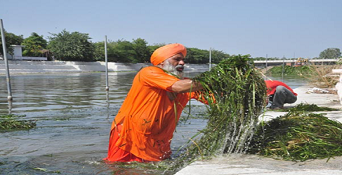The Kali Bein and its significance for Sikhs
Punjab Chief Minister has been admitted to Delhi’s Apollo Hospital, days after he had drunk a glass of water directly from the Kali Bein, a holy rivulet in Sultanpur Lodhi to mark the 22nd anniversary of the cleaning project, which had started on July 16, 2000.
Context
Punjab Chief Minister has been admitted to Delhi’s Apollo Hospital, days after he had drunk a glass of water directly from the Kali Bein, a holy rivulet in Sultanpur Lodhi to mark the 22nd anniversary of the cleaning project, which had started on July 16, 2000.
What is the Kali Bein?
- The 165-km rivulet starts from Hoshiarpur, runs across four districts and meets the confluence of the rivers Beas and Sutlej in Kapurthala.
- Along its banks are around 80 villages and half a dozen small and big towns.
- Waste water from there as well as industrial waste used to flow into the rivulet via a drain, turning its waters black, hence the name Kali Bein (black rivulet).
- Dense grass and weeds grew on the water until a cleaning project started.
Historical background
- The Kali Bein is of great significance to Sikh religion and history, because the first Guru, Nanak Dev, is said to have got enlightenment here.
- When Guru Nanak Dev was staying at Sultanpur Lodhi with his sister Bebe Nanki, he would bathe in the Kali Bein.
- He is said to have disappeared into the waters one day, before emerging on the third day.
- The first thing he recited was the “Mool Mantra” of the Sikh religion.

How did the cleaning project start?
- It was started by environmentalist Baba Balbir Singh Seechewal (now AAP Rajya Sabha MP), a former Punjab Pollution Control Board (PPCB) member, with a handful of followers, without government help.
- They removed weeds, treated the water and spread awareness among residents.
- Six years of hard work paid off when then President A P J Abdul Kalam visited the site in 2006 and praised them for their effort.
- The then Congress government in Punjab then announced that it would take up the project to stop the discharge of untreated water into the rivulet.
- The government identified around 73 villages in three districts releasing sewer water into the Kali Bein.
- The project required every village to build a large pond to collect the sewer water, which would be processed in a water treatment plant and the water then used for irrigation.
- The land for the ponds was to be provided by panchayats.

